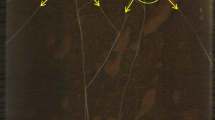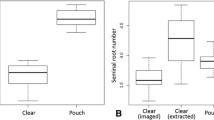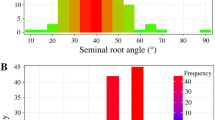Abstract
Key message
Greater embryo size in a large and carefully phenotyped mapping population was genetically associated with a greater number of longer seminal roots to increase grain yield in droughted field environments.
Abstract
Breeding modification of root architecture is challenging in field environments owing to genetic and phenotypic complexity, and poor repeatability with root sampling. Seeds from a large mapping population varying in embryo size were harvested from a common glasshouse and standardised to a common size before assessing in rolled germination paper at 12 and 20 °C for seedling growth. Differences in genotype means were large and heritabilities high (h2 = 0.55–0.93) indicating strong and repeatable genotypic differences for most root traits. Seminal roots 1 to 3 were produced on all seedlings, whereas growth of seminal roots 4, 5 and 6 was associated with differences in embryo size. Increases in seminal root number from 4 to 6 per plant were strongly, genetically correlated with increases in total seminal length (rg = 0.84, < 0.01). Multivariate analysis confirmed initiation and growth of seminal roots 1, 2 and 3, and of roots 4, 5 and 6 behaved as genetically independent (rPg = 0.15 ns) cohorts. Tails representing extremes in seedling root length and number were associated with significant differences in grain yield of up to 35% in droughted field environments but were not different in irrigated environments. Increases in grain yield were linked to greater lengths of seminal roots 4, 5 and 6 and were largely independent of plant height or development. This is the first report on the genetic relationship of seedling root architecture and embryo size, and potential in selection of seminal root size for accessing deep-soil moisture in droughted environments.






Similar content being viewed by others
Data availability statement
Data will be made available upon request to the corresponding author.
References
Adeleke E, Millas R, McNeal W, Faris J, Taheri A (2020) Variation analysis of root system development in wheat seedlings using root phenotyping system. Agron 10:206
Aharon S, Fadida-Myers A, Nashef K, Ben-David R, Lati RN, Peleg Z (2021) Genetic improvement of wheat early vigor promote weed-competitiveness under Mediterranean climate. Pl Sci 303:110785
Alemu A, Feyissa T, Maccaferri M, Sciara G, Tuberosa R, Ammar K, Badebo A, Acevedo M, Letta T, Abeyo B (2021) Genome-wide association analysis unveils novel QTLs for seminal root system architecture traits in Ethiopian durum wheat. BMC Gen 22:1–16
Andalo C, Raquin C, Machon N, Godelle B, Mousseau M (1998) Direct and maternal effects of elevated CO2 on early root growth of germinating Arabidopsis thaliana seedlings. Ann Bot 81:405–411
Aparicio N, Villegas D, Araus JL, Blanco R, Royo C (2002) Seedling development and biomass as affected by seed size and morphology in durum wheat. J Agric Sci (camb) 139:143–150
Atkinson JA, Wingen LU, Griffiths M, Pound MP, Gaju O, Foulkes MJ, Wells DM (2015) Phenotyping pipeline reveals major seedling root growth QTL in hexaploid wheat. J Exp Bot 66:2283–2292
Bai C, Liang Y, Hawkesford MJ (2013) Identification of QTLs associated with seedling root traits and their correlation with plant height in wheat. J Exp Bot 64:1745–1753
Beavis WD (2019) 10 QTL analyses: power, precision, and accuracy. In: Molecular dissection of complex traits, CRC press, pp 145–162
Beyer S, Daba S, Tyagi P, Bockelman H, Brown-Guedira G, Mohammadi M (2019) Loci and candidate genes controlling root traits in wheat seedlings-a wheat root GWAS. Func Int Gen 19:91–107
Christopher J, Christopher M, Jennings R, Jones S, Fletcher S, Borrell A, Hammer G (2013) QTL for root angle and number in a population developed from bread wheats (Triticum aestivum) with contrasting adaptation to water-limited environments. Theor App Gen 126:1563–1574
Condon AG, Richards RA, Rebetzke GJ, Farquhar GD (2002) Improving intrinsic water-use efficiency and crop yield. Crop Sci 42:122–131
Edelman J, Shibko SI, Keys AJ (1959) The role of the scutellum of cereal seedlings in the synthesis and transport of sucrose. J Exp Bot 10:178–189
El Hassouni K, Alahmad S, Belkadi B, Filali-Maltouf A, Hickey LT, Bassi FM (2018) Root system architecture and its association with yield under different water regimes in durum wheat. Crop Sci 58:2331–2346
Elwell AL, Gronwall DS, Miller ND, Spalding EP, Durhum Brooks TL (2011) Separating parental environment from seed size effects on next generation growth and development in Arabidopsis. Pl Cell Env 34:291–301
Fasoulas A (1963) Breeding aspects of embryo size variation in wheat. In: SJ Geerts (ed) Proc. XI. Int. Cong. Gen. Vol 1, pp 246–247
Fischer RA, Byerlee D, Edmeades G (2014) Crop yields and global food security. ACIAR, Canberra, ACT, pp. 8–11
Fischer RA, Rebetzke GJ (2018) Indirect selection for potential yield in early generation, spaced plantings of wheat and other small grain cereals: a review. Crop past Sci 69:439–459
Golan G, Hendel E, Méndez Espitia GE, Schwartz N, Peleg Z (2018) Activation of seminal root primordia during wheat domestication reveals underlying mechanisms of plant resilience. Plant Cell Env 41:755–766
Hendriks PW, Kirkegaard JA, Lilley JM, Gregory PJ, Rebetzke GJ (2015) A tillering inhibition gene influences root-shoot carbon partitioning and pattern of water use to improve wheat productivity in rainfed environments. J Exp Bot 67:327–340
Hendriks PW, Ryan PR, Hands P, Rolland V, Gurusinghe S, Weston LA, Rebetzke GJ, Delhaize E (2022a) Recurrent selection for shoot vigour in wheat (Triticum aestivum L.) is associated with increased root hair length and density and reduced cell sizes. J Exp Bot 73:2499–2510
Hendriks PW, Gurusinghe S, Ryan P, Rebetzke GJ, Weston L (2022b) Competitiveness of early vigour winter wheat (Triticum aestivum L.) genotypes is established at early growth stages. MDPI Agron 12:377
Holland JB, Nyquist WE, Cervantes-Martínez CT (2003) Estimating and interpreting heritability for plant breeding: an update. Pl Breed Rev 22:9–112
Holland JB (2006) Estimating genotypic correlations and their standard errors using multivariate restricted maximum likelihood estimation with SAS Proc MIXED. Crop Sci 46:642–654
Hoshikawa K (1964) Studies on the Ripening of Wheat Grain: 7. Development of embryo with special reference to the differentiation of seminal roots. Jap J Crop Sci 33:119–124
Huang BR, Taylor HM, McMichael BL (1991a) Growth and development of seminal and crown roots of wheat seedlings as affected by temperature. Env Exp Bot 31:471–477
Kiær LP, Weisbach AN, Weiner J (2013) Root and shoot competition: a meta-analysis. J Ecol 101:1298–1312
Klepper B, Belford RK, Rickman RW (1984) Root and Shoot Development in Winter Wheat. Agron J 76:117–122
Kirkegaard JA, Lilley JM (2021) Using systems agronomy to exploit deep roots in crops. In: Gregory PJ (ed.) Understanding and improving crop root function, Burleigh Dodds, Cambridge UK
Korol AB, Ronin YI, Itskovich AM, Nevo PJ, E, (2001) Enhanced efficiency of quantitative trait loci mapping analysis based on multivariate complexes of quantitative traits. Genet 157:1789–1803
Li X, Ingvordsen C, Weiss M, Rebetzke GJ, Condon AG, James RA, Richards RA (2019) Deeper roots are associated with cooler canopy temperatures and greater yields across multiple wheat populations. J Exp Bot 70:4963–4974
Liao MT, Fillery IRP, Palta JA (2004) Early vigorous growth is a major factor influencing nitrogen uptake in wheat. Func Pl Biol 31:121–129
Lilley JM, Kirkegaard JA (2011) Benefits of increased soil exploration by wheat roots. Fld Crops Res 122:118–130
Lopez MS, Reynolds MP (2010) Partitioning of assimilates to deeper roots is associated with cooler canopies and increased yield under drought in wheat. Func Pl Biol 37:147–156
Littell RC, Milliken GA, Stroup WW, Wolfinger RD, Schabenberger O (2007) SAS system for mixed models, 2nd edn. SAS Institute, Cary, NC
Lopez-Castaneda C, Richards RA, Farquhar GD, Williamson RE (1996) Seed and seedling characteristics contributing to variation in early vigor among temperate cereals. Crop Sci 36:1257–1266
Lynch JP (2007) Roots of the second green revolution. Aust J Bot 55:493–512
MacKey J (1973) The wheat root. In: Sears ER, Sears LMS eds, Proc. of the 4th Int. Wheat Genetics Symposium. Agric. Exp. Stn, Univ. of Missouri, Columbia, pp 827–842
MacKey J (1978) Wheat domestication as a shoot-root interrelation process. In: Ramanujam S (ed.) 5th Int Wheat Genetics Symposium, Vol. II, New Delhi
Maydup ML, Graciano C, Guiamet JJ, Tambussi EA (2012) Analysis of early vigour in twenty modern cultivars of bread wheat (Triticum aestivum L.). Crop past Sci 63:987–996
Meister R, Rajani MS, Ruzicka D, Schachtman DP (2014) Challenges of modifying root traits in crops for agriculture. Trends Pl Sci 19:779–788
Meyer WS (1976) Seminal roots of wheat: manipulation of their geometry to increase the availability of soil water and to improve the efficiency of water use. Dissertation, Uni of Adelaide)
Moore C, Rebetzke GJ (2015) Genetic control and genomic regions for embryo size and early vigour in multiple wheat populations. MDPI Agron 5:152–179
Morgan JM, Condon AG (1986) Water-use, grain-yield and osmoregulation in wheat. Aust J Pl Phys 13:523–532
Palta JA, Chen X, Milroy SP, Rebetzke GJ, Dreccer MF, Watt M (2011) Large root systems: are they useful in adapting wheat to dry environments? Fun Pl Biol 38:347–354
Pang J, Palta JA, Rebetzke GJ, Milroy SP (2013) Wheat genotypes with early vigour accumulated more N and had higher photosynthetic N use efficiency during early growth. Fun Pl Biol 41:215–222
Pantalone VR, Rebetzke GJ, Burton JW, Carter TC Jr (1996) Phenotypic evaluation of root traits in soybean, and applicability to plant breeding. Crop Sci 36:456–459
Passioura JB (1977) Grain yield, harvest index, and water use of wheat. J Aust Inst Agric Sci 43:117–120
Rebetzke GJ, Richards RA (1999) Genetic improvement of early vigour in wheat. Aust J Agric Res 50:291–301
Rebetzke GJ, Lopez-Casteneda C, Botwright-Acuna T, Condon AG, Richards RA (2008) Inheritance of coleoptile tiller appearance and size in wheat. Aust J Agric Res 59:863–873
Rebetzke GJ, Condon AG, Rattey AR, Farquhar GD, Richards RA (2013) Genomic regions for canopy temperature and their genetic association with stomatal conductance and grain yield in bread wheat (Triticum aestivum L.). Fun Pl Biol 40:14–26
Rebetzke GJ, Richards RA, Holland JB (2017) Population extremes for assessing trait value and correlated response of genetically complex traits. Fld Crops Res 201:122–132
Ren Y, He X, Liu D, Li J, Zhao X, Li B, Tong Y, Zhang A, Li Z (2012) Major quantitative trait loci for seminal root morphology of wheat seedlings. Mol Breed 30:139–148
Rich SM, Christopher J, Richards R, Watt M (2020) Root phenotypes of young wheat plants grown in controlled environments show inconsistent correlation with mature root traits in the field. J Exp Bot 71:4751–4762
Richard CA, Hickey LT, Fletcher S, Jennings R, Chenu K, Christopher JT (2015) High-throughput phenotyping of seminal root traits in wheat. Pl Meth 11:13
Richards RA, Lukacs Z (2002) Seedling vigour in wheat-sources of variation for genetic and agronomic improvement. Aust J Agric Res 53:41–50
Rickman RW, Klepper B, Belford RK (1985) Developmental relationships among roots, leaves and tillers in winter wheat. Wheat growth and modelling. Springer, Boston, pp 83–98
Roach DA, Wulff RD (1987) Maternal effects in plants. Ann Rev Ecol Syst 18:209–235
Robertson BM, Waines JG, Gill BS (1979) Genetic Variability for Seedling Root Numbers in Wild and Domesticated Wheats Crop Sci 19:843–847
Rufo R, Salvi S, Royo C, Soriano JM (2020) Exploring the genetic architecture of root-related traits in Mediterranean bread wheat landraces by genome-wide association analysis. Agron 10:613
Ryan PR, Liao M, Delhaize E, Rebetzke GJ, Weligama C, Spielmeyer W, James RA (2015) Early vigour improves phosphate uptake in wheat. J Exp Bot 66:7089–7100
Sadras VO, Lawson C (2011) Genetic gain in yield and associated changes in phenotype, trait plasticity and competitive ability of South Australian wheat varieties released between 1958 and 2007. Crop past Sci 62:533–549
Sanguineti MC, Li S, Maccaferri M, Corneti S, Rotondo F, Chiari T, Tuberosa R (2007) Genetic dissection of seminal root architecture in elite durum wheat germplasm. Ann Appl Biol 151:291–305
Sayre KD, Rajaram S, Fischer RA (1997) Yield potential progress in short bread wheats in northwest Mexico. Crop Sci 37:36–42
Shorinola O, Kaye R, Golan G, Peleg Z, Kepinski S, Uauy C (2019) Genetic screening for mutants with altered seminal root numbers in hexaploid wheat using a high-throughput root phenotyping platform G3: Genes. Genomes, Gen 9:2799–2809
Singh J, Clavijo Michelangeli JA, Gezan SA, Lee H, Vallejos CE (2017) Maternal Effects on Seed and Seedling Phenotypes in Reciprocal F 1 Hybrids of the Common Bean (Phaseolus vulgaris L.). Front Pl Sci 8:42
Soriano JM, Alvaro F (2019) Discovering consensus genomic regions in wheat for root-related traits by QTL meta-analysis. Sci Reports 9:1–14
Spielmeyer V, Hyles J, Joaquim P, Azanza F, Bonnett D, Ellis ME, Richards RA (2007) A QTL on chromosome 6A in bread wheat (Triticum aestivum) is associated with longer coleoptiles, greater seedling vigour and final plant height. Theo Appl Gene 115:59–66
Taylor JW, McCall MA (1936) Influence of temperature and other factors on the morphology of the wheat seedling. J Agr Res 52:557–568
Troughton A, Whittington WJ (1969) The significance of genetic variation in root systems. In: Whittington WJ (ed) Root growth. Butterworths, London, pp 296–314
Verbyla AP, De Faveri J, Deery DM, Rebetzke GJ (2021) Modelling temporal genetic and spatio-temporal residual effects for high-throughput phenotyping data. Aust NZ J Stat 63:284–308
Voorrips RE (2002) MapChart: Software for the graphical presentation of linkage maps and QTLs. J Hered 93:77–78
Wasson AP, Richards RA, Chatrath R, Misra S, Sai Prasad SV, Saxena DC, Rebetzke GJ, Kirkegaard JA, Christopher J, Watt M (2012) An ideotype breeding approach for root system traits to increase water uptake and yield in dry environments. J Exp Bot 63:3485–3498
Wasson A, Rebetzke GJ, Kirkegaard JA, Christopher J, Richards RA, Watt M (2014) Soil coring at multiple field environments can directly quantify variation in deep root traits to select wheat genotypes for breeding. J Exp Bot 65:6231–6249
Watt M, Magee LJ, McCully ME (2008) Types, structure and potential for axial water flow in the deepest roots of field-grown cereals. New Phyt 178:135–146
Watt M, Moosavi S, Cunningham S, Kirkegaard JA, Rebetzke GJ, Richards RA (2013) A rapid, controlled-environment seedling root screen for wheat correlates well with rooting depths at vegetative, but not reproductive, stages at two field sites. Ann Bot 112:447–455
Wojciechowski T, Gooding MJ, Ramsay L, Gregory PJ (2009) The effects of dwarfing genes on seedling root growth of wheat. J Exp Bot 60:2565–2573
Xie Q, Fernando KM, Mayes S, Sparkes DL (2017) Identifying seedling root architectural traits associated with yield and yield components in wheat. Ann Bot 119:1115–1129
Zerner RK, Gill GS, Rebetzke GJ (2016) Stability of wheat cultivars in weed competitive ability in differing environments in southern Australia. Crop past Sci 67:695–702
Zhang L, Condon AG, Richards RA, Rebetzke GJ (2015) Recurrent selection for wider seedling leaves increases early leaf area development in wheat (Triticum aestivum L.). J Exp Bot 66:1215–1226
Acknowledgements
We would like to thank Drs Michelle Watt and Anton Wasson for an early discussion on use of the seedling roll method, and Dr Wolfgang Spielmeyer for providing the seed for the Chuan Mai-18 × Vig18 population. We would also like to thank Dr John Kirkegaard and Pieter Hendriks for thoughtful comments in drafting of this manuscript. We also thank the China Scholarship Council (CSC) for support of Dr Hong Zhang through a CSC scholarship.
Funding
The authors have no relevant financial or non-financial interests to disclose.
Author information
Authors and Affiliations
Contributions
GJR designed, analysed and led the writing of the initial draft of the paper. HZ designed and undertook some of the experiments. CI contributed to the writing of the paper. TC designed, analysed and contributed to the writing of the paper. SR contributed to the writing of the paper. ME designed and undertook some of the experiments.
Corresponding author
Ethics declarations
Conflicts of interest
On behalf of all authors, the corresponding author states that there is no conflict of interest.
Ethics
None to declare.
Consent to participate
Not applicable.
Consent for publication
Not applicable.
Additional information
Communicated by Andreas Graner.
Publisher's Note
Springer Nature remains neutral with regard to jurisdictional claims in published maps and institutional affiliations.
Supplementary Information
Below is the link to the electronic supplementary material.
Rights and permissions
About this article
Cite this article
Rebetzke, G.J., Zhang, H., Ingvordsen, C.H. et al. Genotypic variation and covariation in wheat seedling seminal root architecture and grain yield under field conditions. Theor Appl Genet 135, 3247–3264 (2022). https://doi.org/10.1007/s00122-022-04183-z
Received:
Accepted:
Published:
Issue Date:
DOI: https://doi.org/10.1007/s00122-022-04183-z




